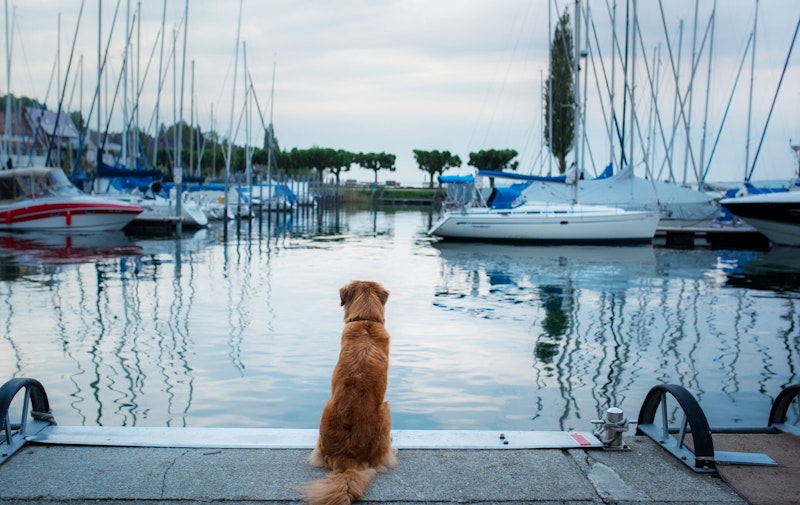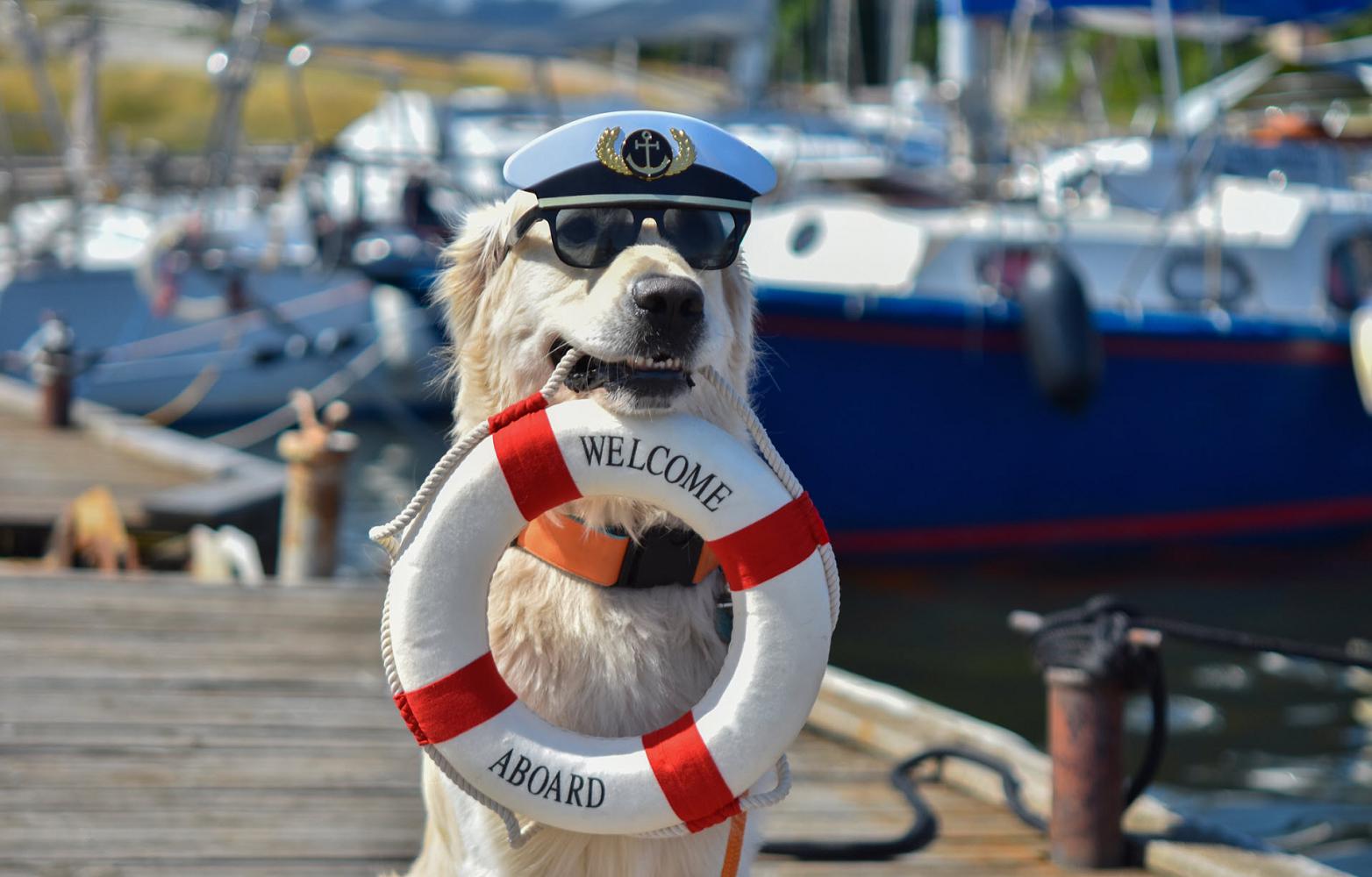There are few things greater in this world than a good day spent boating and the love of a good dog. Combining the two can be a great experience for both of you. With a little preparation and some handy accessories, bringing your pup along for a multi-night cruise can mean you don't have to leave your best friend behind. From leaping off of the gunwale into the water to chase a dolphin or using the bathroom on your newly cleaned teak deck, there are certain challenges that come with bringing your pet on board your boat.
With boating becoming increasingly more popular as a recreation and many more people choosing to become liveaboard boat owners, the ability to adapt your pet to life on the water is becoming easier because it is becoming more common. With the ability to connect easily with other dog-loving boaters and group share tips and tricks online, social media can offer up some great advice. Facebook Groups like "Boat Owners United", for example, have a lot of helpful people that are keen to share what has worked for them! We've compiled a list of advice from experts, lessons learned, and useful accessories that can help you overcome the obstacles of bringing your dog on your boat or yacht for extended periods of time.
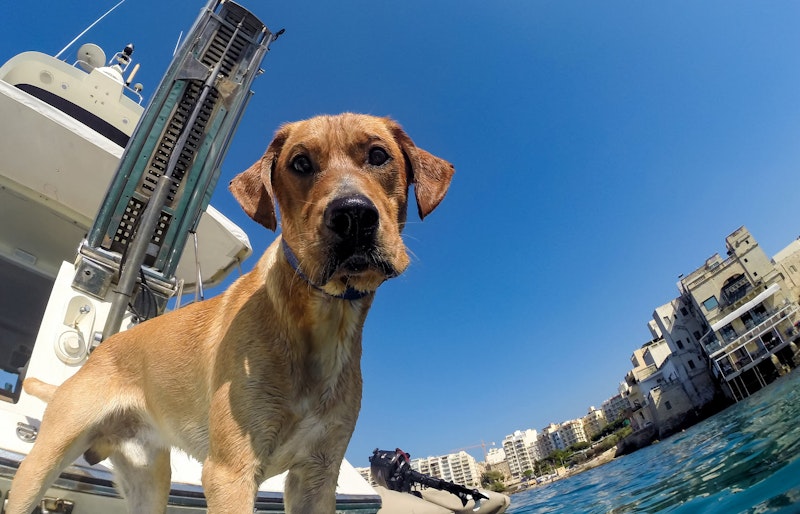
Take It Slow, Try A Day At The Sandbar Or A Short Cruise To Lunch
This might seem like a no-brainer, but doing a few test runs on your boat with your dog can mean a world of difference when it comes time to take your trip. Sandbars are excellent places for dogs to run around and enjoy the water. If you're in a yacht, anchoring in deeper water and loading your dog on to the tender can be great practice for accessing the beach or sandbar. Even taking your dog for a short cruise to lunch can get them used to the movement of the boat and all of the things they may encounter. After two or three short trips, you may even try an overnighter so that your pup has the experience of sleeping on the boat.
Tips For Getting On And Off Your Boat With Your Dog
Timid or unconfident dogs can hesitate when moving from the dock to your boat causing a slip into the water. It's not unfathomable to have a pet fall in the water at the dock and then struggle to get back on the dock, particularly at a busy marina. If you're a small dog owner, carrying him or her on to the boat might just be easier than training it. A harness with a handle on top is always smart. Just in case they do fall in, having a handle to help lift them out can make things easier.
For bigger dogs, try walking them on board with treats to keep their attention. Sometimes tossing a treat on board in front of them can be enough to encourage them to cross the gangway. From the very beginning use verbal cues your dog is used to hearing, as well as hand signals. Keeping them leashed during this time is encouraged, but make sure not to pull or force them on to the boat. If for some reason your dog isn't motivated by treats, incorporating one of their favorite toys into the process can also work. Some yachts had side deck gates that open for easy boarding and are close to being level with the deck.
(Seen below: Many trawler yacht brands like Fleming offer easy boarding functionality built right in. Photo cred: Scott Pearson)
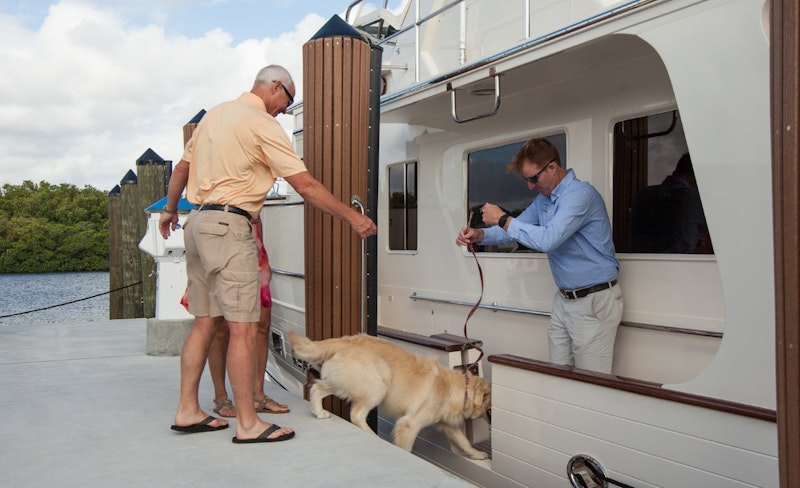
Boarding from the water after swimming can also create challenges. If your yacht has a hydraulic swim platform that lowers into the water, you're all set. If not, consider purchasing the Solstice Inflatable Pup Plank to make it easier on you and them for getting back onto the boat after a swim. The bottom of the mesh area is weighted to keep it under the water while they board. Consider setting a treat in front of the Pup Plank to encourage them to use it.
Lining part of your swim platform with synthetic turf can also give your dog's claws something to grip as they pull themselves up. This will save your teak platform from getting scratches.
(Seen below: The Solstice Pup Plank can be ordered online and is a durable option.)

Give Your Dog Their Own Spot On The Boat
Dogs are creatures of habit and will feel confident on board your boat if they have their own place. If you're planning on a multi-night trip, think about bringing your dog's favorite bed along with either his/her crate or a movable baby gate. Should you choose to dock at a restaurant and want to leave your pup on board, this will ensure they don't start chewing on something they aren't supposed to.
Potty Train Your Boat Dog
Where your dog will go to the bathroom is the number one concern many pet-owning boaters have when cruising. It's not always feasible to hop in your tender and motor over to the nearest island or dock to let them do their business. Just like they have their own space on your boat to rest, also give them a designated area to go to the bathroom. PorchPotty.com has an excellent option for less than $300 that is capable of handling the needs of larger dogs. If you're going offshore or for an extended period of time, it might make sense to invest in a portable dog bathroom
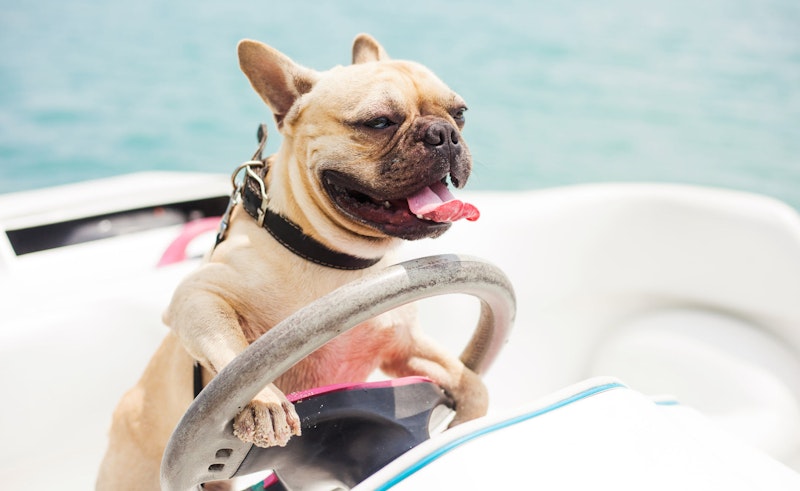
When Long-Distance Cruising, Bring Your Dog's Papers
Anyone who has cruising experience knows the value of making a list during your preparation. If you plan on bringing your pup with you on the boat for an extended period of time, make sure their vaccination papers are on the list along with pertinent vet records. Will you be crossing over into another country? Do your research ahead of time to find out what is expected of you in regards to your pets on board. Something as simple as a missed vaccination date can mean you can't enter the country.
Keep in mind too, some countries don't allow imported pets at all. Jamaica is an island that does not allow imported pets, for example.
Yes, Some Dogs Do Get Seasick
One thing to keep in mind is dogs do get seasick from the motion of the boat. Some dogs will never have a problem and some have a difficult time handling the rolling of the waves. Larger motor yachts tend to not roll as much thanks to their heavier displacement. One boat owner on CruisersForum.com brought ginger snaps along for boat rides with his beagle who occasionally got motion sickness. Others suggested timing the traveling part of your boating after your dog's food has digested and keeping the boat speed slower when on a full stomach. Consult with your vet on what medications are available to help your dog with motion sickness.
(Below: Youtubers 'The O'Kelly's' talk about cruising the Caribbean with their dog on a sailing catamaran.)
Will You Be Fishing On Board?
Nothing ruins a trip like an impromptu visit to the emergency room, a veterinarian one that is. Cut bait, live bait, and even artificial baits can smell like a treat to a dog and nothing would be worse than a self-setting circle hook piercing your puppy's lip. If you're going to be fishing on board, make sure your bait, especially any bait with hooks in it, are kept out of reach. If you're bringing your dog on a sportfishing boat that has things like gaffs or knives at a bait cutting station, it might be best to keep your dog in the salon until everything is cleaned up.
More Random Uncategorized Advice
In addition to the above considerations, here are some more pointers for bringing your dog cruising with you on your boat.
- Search for LifeTag Wirelsss Man Overboard System. This wearable personal locater beacon can easily be strapped to a dog's collar.
- Remember to fill your dog's water bowl frequently, especially when cruising in warm, sunny climates.
- It doesn't hurt to look what vet offices might be on your cruising route just in case of an emergency.
- If cruising for longer distances, bring enough toys for your dog. Exercising them may not be feasible.
- If you can afford one, get a Seakeeper Gyro. The stabilization will help your pets and your guests!
If you're still wondering whether or not to take your dog on your boating trip with you, only you can make the decision by weighing the benefits with the temperament of your pet. So pull in the "bow-lines" and take off with your best four-legged friend to make the best boating memories with confidence. You'll be glad you didn't leave them behind!
